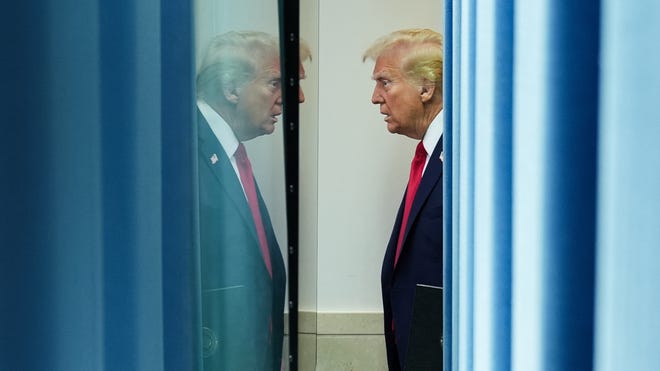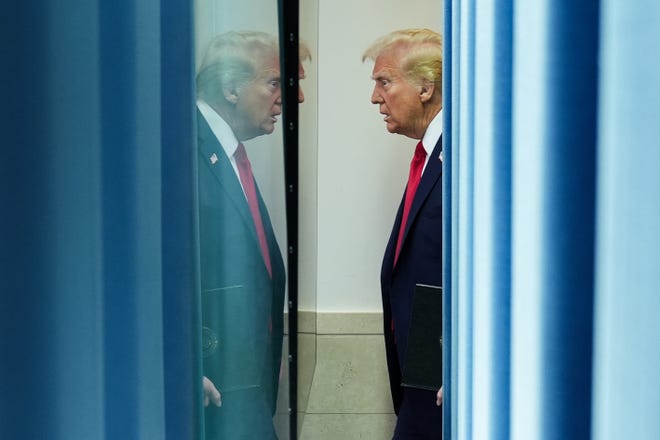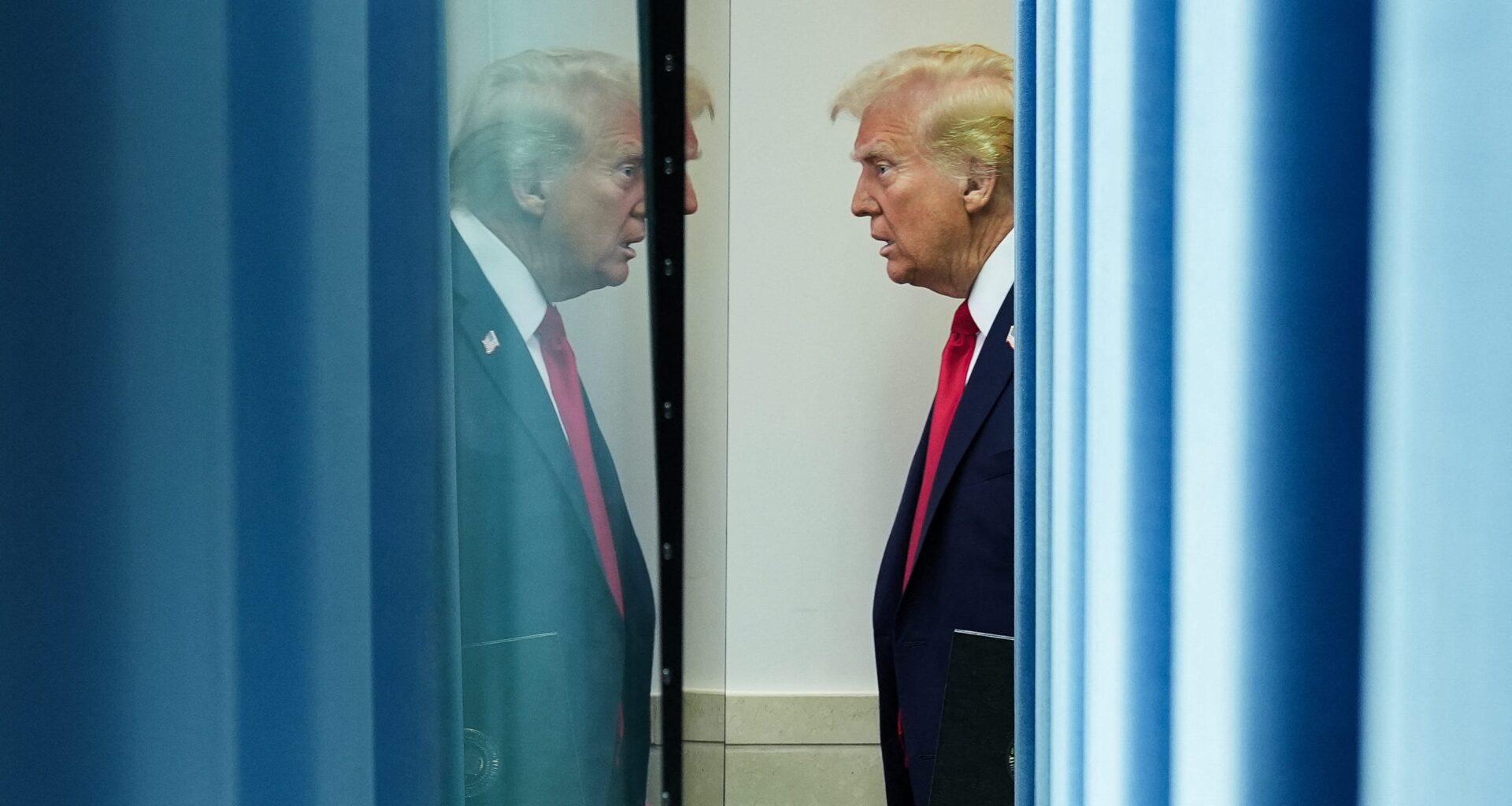
WASHINGTON – It was the type of moment when Americans traditionally look to a leader for comfort: grieving the loss of 67 people killed when a commercial airliner and a military helicopter collided over the skies of Washington.
And when Donald Trump stepped behind the White House briefing room podium on Thursday to fulfill his role as consoler-in-chief, he started his remarks by asking for a moment of silence in honor of the victims and their families.
But soon after the silent reflection had ended, Trump went on the attack, blaming the tragedy on his two Democratic predecessors and their emphasis on diversity in hiring, which he claimed had lowered standards for air traffic controllers.
Trump did not provide evidence to back up his statements. When a reporter pressed him on how he could point to diversity, equity and inclusion hiring practices as the reason for the crash, he shot back: “Because I have common sense.”

Americans have often turned to their leaders in times of tragedy, hoping they can help bind the nation’s wounds and somehow make sense out of events that are often senseless.
Ronald Reagan lauded the heroism of the doomed astronauts aboard the Space Shuttle Challenger, who were killed when the aircraft exploded shortly after takeoff in 1986. “We will never forget them,” he said during a televised address from the Oval Office, recalling how they prepared for their journey and “slipped the surly bonds of earth to touch the face of God.”
Looking back:‘Oh my God, no!’ Space shuttle Challenger exploded 39 years ago
After the terrorist attacks on Sept. 11, 2001, George W. Bush, just eight months into his presidency, stood atop the still-smoldering rubble of the World Trade Center, bullhorn in hand, and promised rescue workers sorting through the debris: “I can hear you! The rest of the world hears you! And the people who knocked these buildings down will hear all of us soon.”
Barack Obama wiped away tears while he mourned the “beautiful little kids” gunned down during a mass shooting at Sandy Hook Elementary School in Connecticut in 2012. “These children are our children,” he said.
Trump, though, has at times offered a different approach to his role of comforter to a grief-stricken nation. During his first term, and at other times before he entered politics, Trump has used moments of national mourning to stress a political point, or to address his critics.
In 2016, during his first campaign for the White House, Trump slammed Obama after a gunman who pledged allegiance to the Islamic State opened fire at a gay nightclub in Orlando, Florida, killing 49 people and wounding 53 others. Trump condemned Obama for not saying the words “radical Islam” and urged him to resign from office.
When 11 people were shot to death at a synagogue in Pittsburgh in 2018, Trump, by then well into his first term, appeared to suggest that fewer would have died if they’d had weapons or if an armed guard had been on hand. “If they had some kind of a protection inside the temple, maybe it could have been a very much different situation,” he said.
A year later, Trump marked the 18th anniversary of the 9/11 terrorist attacks with somber expressions and political attacks. He started the morning by going on Twitter and posting a photo of himself and first lady Melania Trump appearing to reflect on the anniversary. “We Will Never Forget,” the caption read.
Ten minutes later, Trump launched into a Twitter criticism of Federal Reserve Chairman Jerome Powell, whom he argued should lower interest rates, and against one of his perennial targets – the media – over a new poll that showed him losing in a hypothetical race against Hillary Clinton and other Democrats.
Then last week, just three days into his second term, Trump took aim at California as devastating wildfires ravaged the state. Trump threatened to withhold wildfire relief unless California reroutes water to the southern part of the state.
“I don’t think we should give California anything until they let water flow down into there,” he said.
DC plane crash:Mapping the flight paths that put jet and helicopter on collision course
Sympathy and politics
On Wednesday night, just two hours after American Airlines Flight 5342 and an Army Black Hawk helicopter collided midair near Ronald Reagan Washington National Airport and plunged into the frigid Potomac River, Trump already appeared to be looking to cast blame.
In a statement posted on his Truth Social platform, he cited the clear night and questioned why the helicopter hadn’t gotten out of the way of the airliner. “Why didn’t the control tower tell the helicopter what to do instead of asking if they saw the plane,” Trump asked. “This is a bad situation that looks like it should have been prevented. NOT GOOD!!!“
He went even further Thursday morning during remarks at the White House, suggesting that Obama and former President Joe Biden were at fault because they had pushed for diversity in hiring when they were in office. He had especially harsh words for Pete Buttigieg, who as Biden’s transportation secretary was in charge of the Federal Aviation Administration.
“That guy’s a real winner,” Trump said sarcastically. “Do you know how badly everything has run since he has run the Department of Transportation? He’s a disaster. He was a disaster as a mayor – he ran his city into the ground – and he’s a disaster now.”
Buttigieg, the former mayor of South Bend, Indiana, quickly returned the fire.
“Despicable,” he said of Trump’s remarks, writing on X: “As families grieve, Trump should be leading, not lying.”
‘No survivors’:What to know about the passengers in DC plane crash
Others also pushed back.
“It’s one thing for internet pundits to spew up conspiracy theories,” Senate Democratic leader Chuck Schumer wrote on X. “It’s another for the President of the United States of America to throw out idle speculation even as victims are still being recovered, and families are still being notified. It turns your stomach.”
Derrick Johnson, president of the NAACP, slammed Trump for “unpresidential, divisive behavior,” and said he was using “the highest office in the land to sow hatred rooted in falsehoods.”
Glimpses of empathy
Amid Trump’s attacks and conjecture about what went wrong, there were moments during his 35-minute morning briefing when the president showed the empathy Americans have come to expect from their leaders in times of crisis.
“We are in mourning,” he said of the aircraft collision, adding, “this has really shaken a lot of people.”
Trump commended the first responders for “a phenomenal job” and mourned the loss of Russian figure skaters who were among the foreign nationals on the flight.
“Our hearts are shattered alongside yours,” he said.
Hours later, though, Trump was back in attack mode.
In the Oval Office, when asked whether he thought race or gender played a role in the midair collision, Trump responded: “It may have. I don’t know. Incompetence might have played a role.”
When a reporter asked whether he planned to visit the crash site, he retorted: “You tell me: What’s the site? The water? You want me to go swimming?”
Michael Collins writes about the White House. Follow him on X @mcollinsNEWS.
